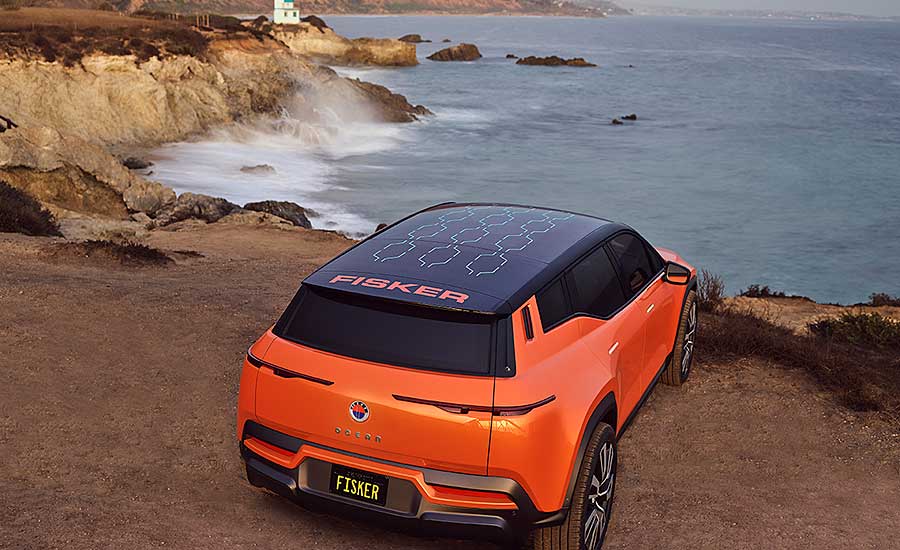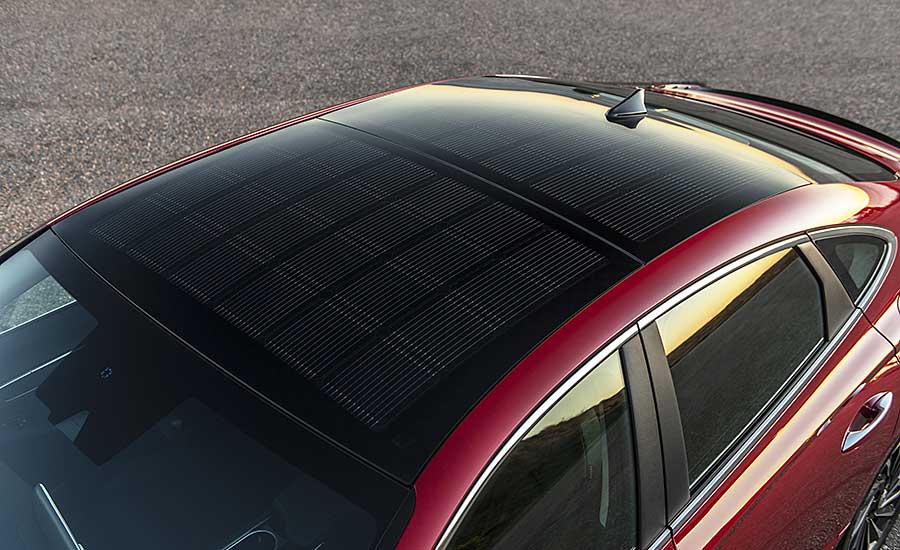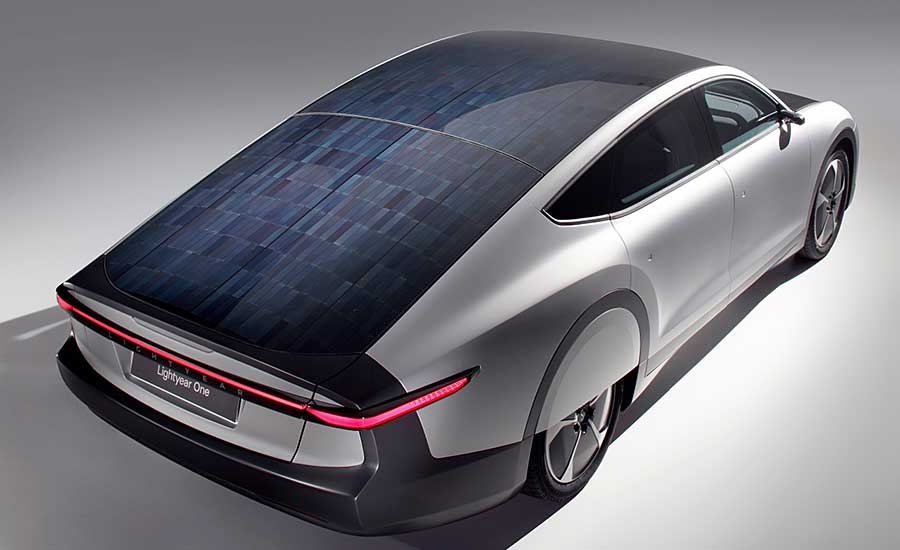Automakers Are Developing Solar-Powered Vehicles
Battery recharging and range issues have been the Achilles heel of electric vehicles. Some automotive engineers believe solar power may be the solution.












Battery recharging and range issues have been the Achilles heel of electric vehicles. Some automotive engineers believe solar power may be the solution.
The goal of vehicle-integrated photovoltaics is to enable EVs to recharge without stopping. Unlike traditional EVs that must periodically pull over to recharge batteries during a long road trip, solar cars can keep on going.
Electric cars and trucks embedded with photovoltaic cells can convert energy from sunlight into electricity. Storing solar energy in batteries enables them to run smoothly at night or in the absence of direct sunlight.
Several start-ups, such as Aptera Motors, Atlis Motor Vehicles, Fisker Inc., Lightyear One and Sono Motors, as well as established OEMs like Hyundai, Tesla and Toyota, are developing solar cars or hybrid versions of them. They are integrating solar cells into roofs. However, other body parts, such as doors, hoods, tailgates and trunks, are also prime real estate.
"Automotive solar panels are a very interesting topic, because the technology can enable electric vehicles to recharge up to 40 percent faster," says Peter Harrop, Ph.D., chairman of IDTechEx, a market research firm that recently published a report on the subject. "Some cars have up to 7 square meters of space available for solar panels.
"The technology has already been successfully used on everything from boats to satellites," notes Harrop. "Any car or truck manufacturer that is not considering solar panel bodywork is crazy."
Solar panels can be attached to vehicle bodies using mechanical fasteners or structural adhesives. However, to be aerodynamic and aesthetically pleasing, automotive engineers prefer to integrate solar modules into body panels.
“While it may be possible to use flexible film in the future, solar panels are not simply stuck onto vehicles today,” explains Harrop. “To achieve the complex shapes needed for car bodies, thin solar cells must be molded into carbon fiber, glass or polycarbonate sheets. They become less like traditional solar panels, because they are actually structural elements.”
As an example, Harrop points to Lightyear One, a Dutch company that plans to launch a “long-range solar electric vehicle designed to be grid independent” later this year. It will feature 5 square meters of integrated solar cells protected by double-curved and super-strong safety glass.
The solar roof will capture sunlight continually whether the car is moving or stationary. Lightyear One claims that feature will deliver enough energy to cover an average of more than 70 percent of annual mileage.
A conductive backsheet produced by Royal DSM is an integral element of Lightyear One’s solar roof. It enables all the connections of the solar cells to be put on the back of the solar panel, which makes every available centimeter on the front of the module available for capturing sunlight.
“The reduction in electrical (cell-to-module) losses not only delivers a 3 percent increase in power output; it has the added advantage of contributing to a more stylish sunroof with aesthetic appeal,” claims Pascal de Sain, vice president of DSM Advanced Solar.
Another solar roof concept was recently developed by engineers at Teijin Ltd. It uses the company’s Panlite polycarbonate resin glazing for its surface.
“[We molded] the roof’s curved surface into an ideal shape, an extremely challenging process in the case of using glass,” says Toshiaki Hotaka, general manager of Teijin’s mobility division. “Not only is the roof ideally shaped, it achieves the strength and rigidity required for the [application.”
The Teijin solar roof was installed on a prototype from Applied Electric Vehicles. During tests conducted in Australia, it achieved output of about 330 watts, which is equivalent to a conventional solar panel housed under glass.
Numerous Benefits
“The benefit of solar-powered vehicles is that they don’t require fuel and have a low cost of maintenance,” says Lex Hoefsloot, CEO of Lightyear One. “Solar cars run longer on the same battery. This requires less charging stops and will get you faster from point A to point B. Solar energy will never run out and it is free.
“Because the pressure on the grid from solar cars is far less, they offer the potential to truly scale clean mobility,” explains Hoefsloot. “From a user perspective, all you need is a regular power outlet combined with the sun; no need to wait for charging infrastructure, again creating a scalable solution.”
Hoefsloot claims that Lightyear One will “consume two to three times less energy than any other electric vehicle on the market today, which results in an exceptional range of 725 kilometers.” However, the overall achievable yield strongly depends on the driving patterns of individuals.
“[Our vehicle] has around 1,000 individual solar cells across the car that ultimately add 50 to 70 kilometers of range per day during summer,” Hoefsloot points out. “[Our solar modules] can charge the car’s battery with up to 12 kilometers of range an hour. These solar cells are 20 percent more efficient than the solar panels you can buy for your home. And, they’re encased in safety glass to protect them from damage.
“We will outsource the production of our vehicles,” says Hoefsloot. “We are currently talking to [several] potential production partners...in Europe.”
“The power that can potentially be generated on a car roof has increased substantially, due to the continuous improvement of solar cell and solar module technology, leading to higher efficiency,” adds Martin Heinrich, Ph.D., head of the department of module technology at the photovoltaics division of the Fraunhofer Institute for Solar Energy Systems. “Therefore, not only a cooling of the passenger cabin could be provided by the solar roof, but even a significant extension of the driving distance could be feasible.”
According to Heinrich, both transparent and opaque photovoltaics can be used for automotive applications. “But, since the available area on vehicles is quite small, we would rather use as much irradiation as possible for power generation instead of receiving light in the vehicle,” he explains.
“Opaque PV works better and offers higher power output, and therefore generates a larger solar range,” says Heinrich. “If transparency is required (such as a sun roof or rear window), transparent solar cell technology can be used, but it currently has a significantly lower power output.”
Heinrich and his colleagues are working on several projects involving solar panel integration into roofs and hoods for passenger cars, including efficient connection to the vehicle power management system. They’re also developing module technology for box bodies on trucks that can be integrated into bodywork seamlessly, without any parts sticking out.
Engineering Challenges
Despite tremendous potential, equipping a vehicle with solar panels presents numerous challenges to automotive engineers. According to Heinrich, there are three big challenges:
- Making the most of the generated energy. Battery charging losses due to self-consumption or charging status where the battery is full but solar power can still be generated must be addressed.
- Manufacturing safe, reliable and cost-effective modules for vehicle integration.
- The reduction of power generation by bad weather and shadowing by other vehicles, in addition to buildings, bridges, trees and tunnels. “This cannot be avoided, but prediction models would provide better estimates for yield calculations and charging optimization,” explains Heinrich.
“There are solutions available to those challenges, but in most cases, they are still being studied,” says Heinrich. “The main technological challenge is the utilization of the generated power. For a high utilization, the high-voltage drivetrain battery is preferred. However, this could lead to significant transformation losses and potentially safety concerns.”
Further challenges arise due to the curvature of car roofs. For instance, a strong curvature may lead to a significant irradiance mismatch and resulting cell power, which could reduce the yield of the solar module. In addition, module and cell technology needs to provide the highest yield, but also a premium aesthetic appearance and durability.
“The challenge with integrating solar cells into an electric vehicle is to maximize the surface area, making sure you achieve automotive-grade standards for reliability and safety, while still optimizing the total performance,” says Arjo van der Ham, chief technology officer at Lightyear One. “Integrating the cells on a double curved surface ensures a great aerodynamic performance of the vehicle, but also creates a challenge in optimizing the yield.
“Normally solar cells are put in series,” explains van der Ham. “In that case, the part in the shadow will reduce the yield of the total panel.
“We have developed proprietary and highly efficient solar electronics to compensate for this loss,” adds van der Ham. “[It enables us] to put groups of cells in parallel. We have also performed many types of impact, heat and vibration tests.”
Another startup firm that has been studying the pros and cons of solar power is Atlis Motor Vehicles Inc. The company is getting ready to produce an electric pickup truck at a new factory in Mesa, AZ. Its innovative XT model, which is aimed at commercial users, will be equipped with a solar panel tonneau cover system called TerraVis.
“We believe there can be a role for solar to play on a full-size truck like ours,” says Mark Hanchett, CEO of Atlis Motor Vehicles. “There are ancillary functions where we feel solar could offer some advantages.
“One example is climate control, especially in hot climates where the sun is high,” notes Hanchett. “Even getting a couple hundred watts from a small solar array may be enough to run fans to provide circulation of air into the cab to avoid the 140 to 160 F peaks that are possible during the summer. Another possible use for on-board solar is for long-term storage, to compensate for parasitic or ‘vampire’ drains on the battery.
“Even in a much shorter term, like during the day on a job site, solar may be able to keep the battery at a consistent level while using power tools or chargers powered from the truck’s on-board power inverter,” Hanchett points out. “For these tasks and more, a smaller set of panels able to make 250 to 500 watts of power would be sufficient.
“The problem comes down to the energy density of solar,” warns Hanchett. “Simply put, only so much energy from the sun is available per square meter, and solar panels can only capture a portion of that energy. Further complications arise from the orientation of the panels.
“[Unlike solar panels on homes], vehicles really only have horizontal surfaces to work with, and they are at a very flat angle, which is not the most optimal for making power,” says Hanchett. “And, parking in partial shade near a tree may also mean that a certain panel can’t make enough power, which can affect the output of the whole array.”
Let the Sun Shine
Several solar-powered cars are currently available, with others on the horizon. Last year, Hyundai Motor Co. unveiled a hybrid version of its popular Sonata sedan that is equipped with a roof-mounted system. It consists of a solar panel and controller that enable the vehicle to generate and store electricity in a battery.
According to Hyundai, the system can charge 30 percent to 60 percent of the battery per day, which can increase the vehicle’s travel distance by an extra 1,300 kilometers annually.
Several startup companies are also jumping on the solar car bandwagon.
Later this year, Aptera Motors Corp. plans to begin mass-producing a three-wheeled solar vehicle at its factory in San Diego. Its carbon-fiber composite body will be covered in 3 square meters of solar cells. The company claims that at least 90 percent of the power produced by the solar panels will go toward propelling the vehicle.
“Integrated solar can be configured to provide up to 45 miles of range per day,” claims Chris Anthony, CEO of Aptera Motors. “[This will be the] first vehicle capable of meeting most daily driving needs using solar power alone.
“Our built-in solar array keeps the battery pack topped off,” explains Anthony. “Never Charge technology is built into every vehicle and is designed to harvest enough sunlight to travel over 11,000 miles per year in most regions.”
Sono Motors is a German start-up company that plans to ramp up production of its Sion vehicle in 2023 at a former Saab plant in Trollhättan, Sweden. Sono's proprietary technology replaces traditional paint with integrated solar panels.
“Solar modules are worked seamlessly into the surface of the body parts to supply vehicles with electricity,” says Mathieu Baudrit, director of photovoltaic integration at Sono Motors. “Drawing on the power of the sun, [our] system will be able to provide energy for an additional range of up to 245 kilometers a week.
“We have found a way to deliver sustainable, free power across various transportation applications by replacing the traditional paint shop process with integrated solar technology,” claims Baudrit. “[Our] solar technology is cheaper, lighter and much more efficient than conventional glass-based solar cells. With a boundless range of potential applications, [it] is a seamless, flexible solution for efficient electric charging.
"We wanted to develop a vehicle that can harvest the maximum amount of energy from the sun," explains Baudrit. "Current technologies available on the market are based on glass photovoltaics, only allowing solar cells to integrate on flat surfaces such as the roof. Having solar cells only on the roof will not harvest the maximum solar energy throughout the entire year, because the sun is lower in the sky during winter.
"We had to create a whole new manufacturing process to integrate the solar cells on the vehicle body, based on injection molding," says Baudrit. "Injection molding is a manufacturing process which allows us to make complex shaped parts out of polymers. It is a very fast manufacturing process, allowing low scrap rate and many different applications.
"[This enables us to] achieve a seamless integration of the photovoltaic function into the car body panels," adds Baudrit. "It is flexible in the sense that we can shape the PV function to the form of the host vehicle as robust as conventional polymer car body panels and cheaper. Thanks to the injection molding process, we remove the need for curved glass.
"We are planning to integrate more than 248 solar cells into the Sion, with a target of having 1.2 kWp of solar cells installed on the vehicle," Baudrit points out. "The solar panels are the body panels. The solar panels will be integrated into the hood, fenders, sides, roof and rear of the vehicle, visually blending into the surface."
Looking for a reprint of this article?
From high-res PDFs to custom plaques, order your copy today!











